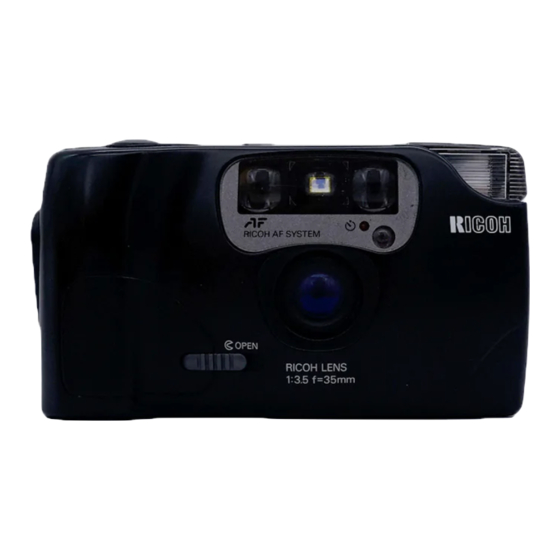Ricoh SHOTMASTER AF SUPER Руководство - Страница 18
Просмотреть онлайн или скачать pdf Руководство для Цифровая камера Ricoh SHOTMASTER AF SUPER. Ricoh SHOTMASTER AF SUPER 20 страниц.

USING THE MULTIPLE EXPOSURE (M.E) MODE
REMOTE CONTROL SOCKET
The multiple exposure capability is used to take several different images on the
same film frame.
Multiple exposures can be easily produced with this mode, so exercise your
imagination to create your own original photographs. (Refer to sample photo.)
1. Set your camera to the M.E Mode. The M.E symbol will be displayed on the
LCD Panel. (Fig. 48)
2. Press the Shutter Release Button to make the first shot, and make second
exposure.
3. Press the Mode Button to cancel the M.E Mode. Then, the film will be wound
automatically Confirm that the "M.E" disappears. (Fig. 49)
* The Exposure Counter will not advance during multiple exposure photography.
* When you ask camera shops to print your pictures, please tell them that
multiple exposures were taken. If not, they may take them for "accidental"
double exposures and not print your shots.
* To use the self-timer in the M.E Mode, first use the Mode Button to select the
M.E Mode. Then press the Self-timer Button.
* The flash can also be used to obtain various special effects.
This camera is equipped with a Remote Control Socket. Various methods of
remote control can be used by plugging an (optional) infrared sensor, audio
sensor, remote controller, etc.. into this socket. A 50 cm electronic cable release
cord, and a 10-meter extension cord, are available from Ricoh as options for use in
remote control photography
Typical installation
1. Remove the cover of the Remote Control Socket to connect your remote
controller. An extension cord can be used for taking photographs at a distance
from subjects. (Fig. 50)
2. Set the camera, aim at the subject and gently press the remote control switch.
The natural expressions of subjects can now be captured from a distance. (Fig. 51)
* Before inserting or pulling out a cord into/from this socket, close the Lens
Shield. If the Lens Shield is left open, the shutter might accidentally be released.
